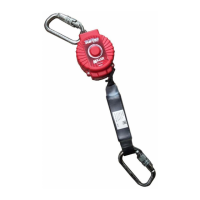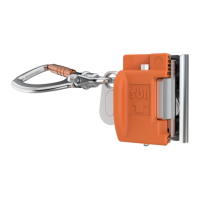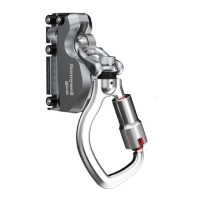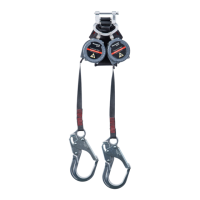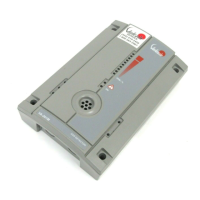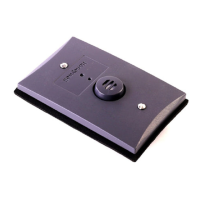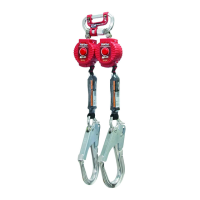12
TABLE 2: Minimum Required Fall Clearances
Minimum Required Fall Clearance
from Work Level to Lower Level*
Maximum
Arrest Distance
of SRL
When Working Directly
Below Anchor Point
When NOT Working
Directly Below
Anchor Point
In Standing
Position
In Kneeling/
Crouched
Position
In Lying
Down
Position
In Potential
Swing Fall Position
24 in (0,6m)
5 ft (1,5m) 8 ft (2,4m) 10 ft (3,1m)
Varies - Additional
Fall Clearance
Required
39 in (1m)
6 ft - 3 in
(1,9m)
9 ft - 3 in
(2,8m)
11 ft - 3 in
(3,4m)
42 in (1m)
7 ft - 6 in
(2,3m)
10 ft - 6 in
(3,2m)
12 ft - 6 in
(3,8m)
*This chart shows general minimum fall clearances required. An exact calculation, based on the SRL/
Fall Limiter to be used and an assessment of the work site and conditions that may affect the worker’s fall
clearance, must be performed.
using a SRL in an overhead application.
See Table 2: Minimum Required Fall
Clearances.
4.1 SelfRetracting Lifeline Fall
Clearance Calculation (See Fig. G)
[Calculation taken from work level]
Maximum Arrest Distance (MAD)
+ [NonStanding Work Position Factor
(NSF)]
+ [Swing Fall Factor (SFF)]
+ 3 ft (0,9m) Safety Factor (SF) =
Required Fall Clearance (RFC)
CAUTION: Read all notes and refer
to all SelfRetracting Lifeline fall
clearance diagrams and labels
to determine exact required fall
clearance for your application.
IMPORTANT NOTES:
SelfRetracting Lifelines must be
anchored overhead to ensure the
accuracy of the fall clearance calculation
and related information.
It is important to understand that other
factors, such as whether the user is
performing work in a standing, crouched
or lying down position and/or whether
the user is working directly below the
anchor point or at an angle, can affect fall
distance when using a retractable device.
The SRL fall clearance calculation
assumes the user is standing. If the user
will be performing work in a crouched
or kneeling position, an additional 3 ft
(0,9m) of fall clearance is required (See
Fig. H). If the user will be performing work
in a lying down position, an additional 5
ft (1,5m) of fall clearance is required.
The SelfRetracting Lifelines fall
clearance calculation also assumes the
user is working directly below the anchor
point, minimizing any possibility for a
swing fall. In a swing fall situation, the
total fall distance will be greater than if
the user were working directly below the
anchor point (See Fig. I).
In some applications, it may not be
possible to work directly below the
anchor point. In such a case, the worker
must increase the fall clearance distance
to account for the swing fall factor. In any
case, the worker must not be exposed to
a potential swing fall where contact with
another object may occur (See Fig. J).
The maximum arrest distance [free
fall (FF) + deceleration (D)] varies by
retractable. Always refer to the labels
on the specific unit to determine the
maximum arrest distance.
If a SelfRetracting Lifelines with a
maximum arrest distance of less than
42 in (1m) has been approved for (by
Honeywell) and is being used in a
non-overhead application, the maximum
arrest distance allowed per standards [42
in (1m)] must be used when calculating
fall clearance distance.

